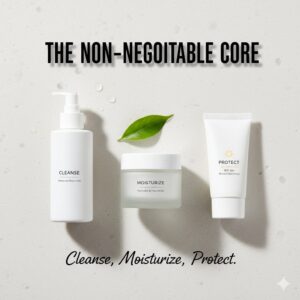Ceramides 101: Ceramides for Skin
If you’ve been dealing with dry, sensitive, or irritated skin, ceramides might be exactly what you need. While they don’t get as much attention as trendy ingredients like retinol or vitamin C, ceramides are actually one of the most important components of healthy skin.
Think of ceramides as the mortar between the bricks of your skin barrier. Without them, your skin can’t hold moisture effectively, becomes vulnerable to irritants, and ages faster. The good news? Adding ceramides to your skincare routine can make a dramatic difference, often within just a few weeks.
Let me explain everything you need to know about these crucial lipids and how to use them effectively.

What Exactly Are Ceramides?
Ceramides are lipids (fats) that make up about 50% of your skin’s outer layer, called the stratum corneum. They’re naturally produced by your skin and play a critical role in maintaining the skin barrier.
To understand why they’re so important, picture your skin barrier as a brick wall. Your skin cells are the bricks, and ceramides, along with cholesterol and fatty acids, are the mortar holding everything together. This structure is often called the “brick and mortar” model of the skin barrier.
The Science Behind Ceramides
Chemically, ceramides are composed of a sphingoid base linked to a fatty acid. This structure makes them perfect for their job because they’re:
- Lipophilic (fat-loving), which allows them to integrate into the skin barrier
- Able to form organized layers that prevent water loss
- Capable of holding cells together tightly
Your skin naturally produces nine different types of ceramides, each with slightly different structures and functions. They work together to:
- Prevent water loss from your skin
- Keep irritants, bacteria, and pollutants out
- Maintain skin flexibility and smoothness
- Regulate cell signaling and skin regeneration
Why Your Skin Loses Ceramides
Unfortunately, ceramide levels in your skin decline over time and due to various factors.
Age-Related Decline
Starting around age 30, your skin’s natural ceramide production begins to slow down. By age 40, you may have lost up to 40% of your skin’s ceramide content. This is one reason why mature skin tends to feel drier and becomes more sensitive.
Environmental Damage
- Sun exposure: UV radiation breaks down ceramides and damages the cells that produce them
- Pollution: Free radicals from pollution degrade skin lipids, including ceramides
- Cold, dry weather: Low humidity pulls moisture from skin, and without adequate ceramides, you can’t retain what’s left
- Indoor heating: Drastically reduces humidity, stressing your skin barrier
Harsh Skincare Practices
- Over-cleansing: Especially with harsh sulfate cleansers that strip natural oils
- Too much exfoliation: Using AHAs, BHAs, or physical scrubs too frequently
- Hot water: Regular exposure to hot showers or baths dissolves skin lipids
- Astringent products: Alcohol-based toners and harsh ingredients
Skin Conditions
Certain conditions are associated with ceramide deficiency:
- Eczema (Atopic Dermatitis): Research shows people with eczema have significantly reduced ceramide levels
- Psoriasis: Altered ceramide composition contributes to the condition
- Rosacea: Often involves a compromised skin barrier with reduced ceramides
- Acne: While acne is often associated with oily skin, the barrier can still be compromised
The Benefits of Using Ceramide Products
When you replenish ceramides through topical products, remarkable things happen to your skin.
Strengthens the Skin Barrier
This is ceramides’ primary function. A strong skin barrier means:
- Better moisture retention
- Protection against environmental aggressors
- Reduced sensitivity to irritants
- Less vulnerability to allergens and bacteria
A healthy barrier is the foundation of healthy skin, regardless of your other concerns.
Reduces Trans-Epidermal Water Loss (TEWL)
TEWL is the scientific term for water evaporating from your skin. High TEWL leads to:
- Chronic dehydration
- Rough, flaky texture
- Increased appearance of fine lines
- Compromised skin function
Ceramides dramatically reduce TEWL, keeping your skin properly hydrated from within.
Soothes Irritation and Sensitivity
If your skin reacts to everything, ceramides can help. By strengthening the barrier:
- Irritants can’t penetrate as easily
- Inflammation decreases
- Skin becomes more resilient
- Sensitivity reactions become less frequent
Enhances Overall Skin Health
Beyond specific concerns, ceramides contribute to:
- Improved skin texture and smoothness
- Better response to other skincare ingredients
- Faster recovery from treatments or irritation
- More youthful, plump appearance
Supports Anti-Aging Efforts
While ceramides aren’t traditionally thought of as anti-aging ingredients like peptides or retinol, they’re crucial for:
- Maintaining skin plumpness
- Reducing the appearance of fine lines from dehydration
- Supporting the effectiveness of other anti-aging ingredients
- Preventing premature aging from barrier damage
Types of Ceramides in Skincare
When you look at skincare labels, you’ll see ceramides listed in different ways. Understanding these can help you choose better products.

The Nine Natural Ceramides
Scientists have identified nine ceramide types in human skin, originally named Ceramide 1 through 9. However, the nomenclature has changed to be more chemically accurate:
- Ceramide EOP (formerly Ceramide 1)
- Ceramide NS/NG (formerly Ceramide 2)
- Ceramide NP (formerly Ceramide 3)
- Ceramide EOH (formerly Ceramide 4)
- Ceramide AS (formerly Ceramide 5)
- Ceramide AP (formerly Ceramide 6)
- Ceramide AH (formerly Ceramide 7)
- Ceramide NH (formerly Ceramide 8)
- Ceramide EOS (formerly Ceramide 9)
You might see either naming system on product labels.
The Most Important Ceramides in Skincare
While all ceramides are beneficial, research highlights a few as particularly important:
Ceramide NP (Ceramide 3): The most abundant ceramide in skin and most commonly used in skincare products. Essential for barrier function and moisture retention.
Ceramide AP (Ceramide 6): Critical for skin barrier structure. Deficiency is linked to aging and various skin conditions.
Ceramide EOP (Ceramide 1): Unique because of its extremely long chain. Particularly important for maintaining barrier integrity and is often deficient in eczema.
Quality ceramide products often contain multiple ceramide types to mimic your skin’s natural composition.
Synthetic vs Natural Ceramides
Synthetic Ceramides: Most skincare products use lab-created ceramides that are chemically identical to human ceramides. These are:
- Highly effective
- More affordable
- Stable in formulations
- Ethically produced
Natural Ceramides: Derived from sources like wheat, rice, or other plants. While these can be beneficial, they’re not identical to human ceramides and may not work as effectively.
Pseudoceramides: Synthetic lipids designed to mimic ceramide function but with different chemical structures. They can still be effective but aren’t true ceramides.
Look for products that specify “ceramide NP,” “ceramide AP,” etc., rather than vague terms like “ceramide complex.”
How to Use Ceramides in Your Routine
Ceramides are incredibly versatile and easy to incorporate into any skincare routine.
Best Products for Ceramide Delivery
Moisturizers: This is the most common and effective way to get ceramides. Look for creams and lotions with ceramides high on the ingredient list.
Serums: Lightweight ceramide serums can be layered under moisturizer for extra barrier support.
Cleansers: Some gentle cleansers include ceramides to minimize the stripping effect of cleansing.
Toners: Hydrating toners with ceramides can provide an extra layer of barrier support.
When to Apply Ceramides
Ceramides can and should be used twice daily, morning and night. Unlike some active ingredients, they don’t increase sun sensitivity and work beautifully at any time.
Layering Ceramides with Other Ingredients
One of the best things about ceramides is they play well with virtually everything. Here’s how to layer them:
Morning Routine:
- Cleanser
- Toner (optional)
- Vitamin C serum
- Hyaluronic acid
- Ceramide moisturizer
- Sunscreen
Evening Routine:
- Cleanser
- Toner (optional)
- Active ingredient (retinol, AHA, etc.)
- Ceramide serum
- Ceramide moisturizer
The Perfect Ceramide Combinations
Ceramides work even better when combined with their natural partners:
Ceramides + Cholesterol + Fatty Acids: This is the golden ratio your skin naturally produces. The ideal ratio is approximately 1:1:1 or 3:1:1 (ceramides:cholesterol:fatty acids). Products formulated with this balance are particularly effective.
Ceramides + Niacinamide: Niacinamide actually stimulates your skin’s natural ceramide production, while topical ceramides provide immediate barrier support. This combination is incredibly powerful.
Ceramides + Hyaluronic Acid: Ceramides prevent water loss while hyaluronic acid draws water in. Together, they create optimal hydration.
Ceramides + Peptides: Peptides work on collagen production while ceramides maintain barrier health. Great for comprehensive anti-aging.
Ceramides + Retinol: Since retinol can be irritating and compromise the barrier initially, using ceramides alongside your retinol routine helps minimize irritation and maintains barrier health.
Choosing Quality Ceramide Products
Not all ceramide products are created equal. Here’s what to look for:
Check the Ingredient List
Ceramides should appear in the first 7-10 ingredients. If they’re at the very end of a long list, the concentration is likely too low to be effective.
Look for specific ceramide types listed by name:
- Ceramide NP
- Ceramide AP
- Ceramide EOP
- Ceramide NG
- Ceramide NS
Avoid vague terms like “ceramide complex” without further specification.
Look for the Complete Lipid Profile
The most effective products include:
- Multiple ceramide types
- Cholesterol
- Fatty acids (often listed as behenic acid, stearic acid, or similar)
This combination mimics your skin’s natural barrier composition.
Consider the Base Formula
Ceramides work best in:
- Cream or lotion formulations (for dry to normal skin)
- Lightweight lotions or gel-creams (for oily or combination skin)
- Rich balms (for extremely dry or compromised skin)
The vehicle matters because ceramides need to be properly formulated to penetrate and integrate into your skin barrier.
Check for Supporting Ingredients
Quality ceramide products often include:
- Niacinamide: Boosts natural ceramide production
- Hyaluronic acid: Provides hydration
- Glycerin: Humectant that works with ceramides
- Panthenol: Supports barrier repair
- Centella asiatica: Soothes and supports healing
Avoid Potential Irritants
Look for products without:
- Heavy fragrances
- Essential oils (if you have sensitive skin)
- Drying alcohols high on the list
- Harsh preservatives
The goal is to support your barrier, not compromise it with irritating ingredients.
How Long Until You See Results?
Ceramides work relatively quickly compared to many skincare ingredients.
Week 1: Immediate improvement in skin hydration and comfort. Reduced tightness and dryness.
Week 2-3: Noticeable improvement in skin texture. Reduced flaking and rough patches. Less sensitivity to other products.
Week 4-6: Significant improvement in overall barrier function. Increased resilience to environmental stressors. Better tolerance of active ingredients.
Week 8+: Optimal barrier health. Skin appears plumper, smoother, and more radiant. Continued improvement in any underlying conditions related to barrier dysfunction.
For conditions like eczema or severe barrier damage, improvement may take longer but should be noticeable within 2-4 weeks.
Ceramides for Different Skin Types
For Dry Skin
Dry skin almost always involves ceramide deficiency. Look for:
- Rich cream formulations
- Multiple ceramide types
- High concentrations (ceramides in top 5 ingredients)
- Additional occlusives like petrolatum or dimethicone
Apply ceramide products on slightly damp skin to seal in moisture.
For Oily Skin
Yes, oily skin needs ceramides too! Many people with oily skin have compromised barriers, which can actually trigger more oil production. Choose:
- Lightweight lotion or gel-cream formulations
- Non-comedogenic bases
- Products with niacinamide to regulate oil production
- Matte-finish options if desired
For Sensitive Skin
Ceramides are particularly beneficial for sensitive skin. Look for:
- Fragrance-free formulations
- Minimal ingredient lists
- Products specifically marketed for sensitive skin
- Multiple ceramide types
- Soothing additional ingredients
For Acne-Prone Skin
Acne treatments can compromise your barrier, making ceramides essential. Choose:
- Non-comedogenic formulations
- Lightweight textures
- Products with niacinamide
- Avoid heavy, occlusive formulas that might clog pores
For Aging Skin
Mature skin has depleted ceramide levels. Look for:
- Rich formulations with multiple ceramides
- Products combining ceramides with anti-aging ingredients like peptides or retinol
- Higher concentrations
- Additional barrier-supporting ingredients

Common Mistakes When Using Ceramides
Expecting Immediate Dramatic Results
Ceramides work behind the scenes to support skin health. You won’t see the dramatic transformation you might expect from retinol, but you’ll notice gradual, sustainable improvement in skin quality.
Using Products with Too-Low Concentrations
Many products list ceramides for marketing but include ineffective amounts. Check that ceramides appear early in the ingredient list.
Not Being Consistent
Ceramides need consistent application to maintain barrier health. Using them sporadically won’t give you optimal results.
Ignoring Other Barrier Components
Ceramides work best with cholesterol and fatty acids. Products with comprehensive lipid profiles are more effective than ceramides alone.
Continuing Harsh Skincare Practices
If you’re using ceramides but still over-exfoliating, using harsh cleansers, or taking hot showers, you’re working against yourself. Adjust your overall routine to support barrier health.
Special Considerations
During Retinoid Treatment
If you’re using retinol or prescription retinoids, ceramides are your best friend. They help:
- Minimize irritation and dryness
- Support the barrier during adjustment
- Reduce flaking and sensitivity
- Improve overall tolerance
Apply ceramide products after your retinoid and in the morning.
Post-Professional Treatments
After peels, laser treatments, or microneedling, your barrier needs extra support. Ceramides help:
- Speed healing
- Reduce downtime
- Minimize irritation
- Protect newly exposed skin
Start using ceramides immediately after treatment (once cleared by your provider).
For Eczema and Dermatitis
Research strongly supports ceramide use for these conditions. Studies show:
- Significant reduction in symptoms
- Decreased need for prescription treatments
- Improved quality of life
- Prevention of flares
Work with your dermatologist to incorporate ceramides into your treatment plan.
In Extreme Climates
Whether you’re in a dry desert or cold winter environment, ceramides are essential:
- Apply extra layers in harsh conditions
- Use richer formulations in cold weather
- Reapply during the day if needed
- Consider using a humidifier indoors
Ceramides vs. Other Barrier-Supporting Ingredients
Ceramides vs. Hyaluronic Acid
Hyaluronic acid draws water into skin, while ceramides prevent that water from escaping. They work synergistically rather than competitively. Use both for optimal hydration.
Ceramides vs. Occlusives (Petrolatum, Dimethicone)
Occlusives sit on top of skin to prevent water loss. Ceramides integrate into the barrier to strengthen it from within. Both are useful, often in the same product.
Ceramides vs. Niacinamide
Niacinamide stimulates your skin’s natural ceramide production. Using both provides immediate barrier support (from topical ceramides) and long-term production (from niacinamide).
The Science: What Research Shows
Ceramide research is extensive and compelling:
For Barrier Function: Multiple studies show that topical ceramides significantly improve barrier function, reducing trans-epidermal water loss by up to 60%.
For Atopic Dermatitis: Clinical trials demonstrate that ceramide-containing moisturizers reduce eczema symptoms as effectively as some prescription treatments when used regularly.
For Aging: Research shows that ceramide-rich moisturizers improve skin hydration, texture, and appearance of fine lines in mature skin.
For Post-Procedure Care: Studies on post-laser and post-peel care show faster healing and reduced complications with ceramide use.
The evidence is clear: ceramides work, and they’re essential for skin health.
Building a Ceramide-Centered Routine
If you’re dealing with barrier issues, consider building your routine around ceramides:
Morning:
- Gentle, ceramide-containing cleanser
- Hydrating toner
- Vitamin C (if tolerated)
- Ceramide serum
- Ceramide moisturizer
- Sunscreen
Evening:
- Gentle, ceramide-containing cleanser
- Hydrating toner
- Active treatment (retinol, if using) OR rest night
- Ceramide serum
- Rich ceramide moisturizer
- Optional: Occlusive layer (Aquaphor, CeraVe Healing Ointment)
Weekly:
- Gentle exfoliation (1-2x/week max)
- Hydrating mask with ceramides
- Skip actives if skin feels compromised
The Bottom Line on Ceramides
Ceramides may not be the most glamorous skincare ingredient, but they’re absolutely essential for healthy skin. Whether you’re dealing with dryness, sensitivity, aging, or just want to maintain optimal skin health, ceramides should be part of your routine.
The science is solid, the results are real, and the risks are virtually nonexistent. Unlike trendy ingredients that come and go, ceramides are fundamental to skin structure and function.
Key takeaways:
- Choose products with multiple ceramide types
- Look for the complete lipid profile (ceramides + cholesterol + fatty acids)
- Use them consistently, twice daily
- Combine with complementary ingredients like niacinamide and hyaluronic acid
- Be patient—results build over time
If your skin feels tight, looks dull, reacts to everything, or just isn’t responding well to other treatments, the problem might be your barrier. Give ceramides a try for at least 4-6 weeks. You might be surprised at how much difference these humble lipids can make.
Your skin barrier is your first line of defense against the world. Give it the ceramides it needs to do its job properly, and everything else in your skincare routine will work better.



